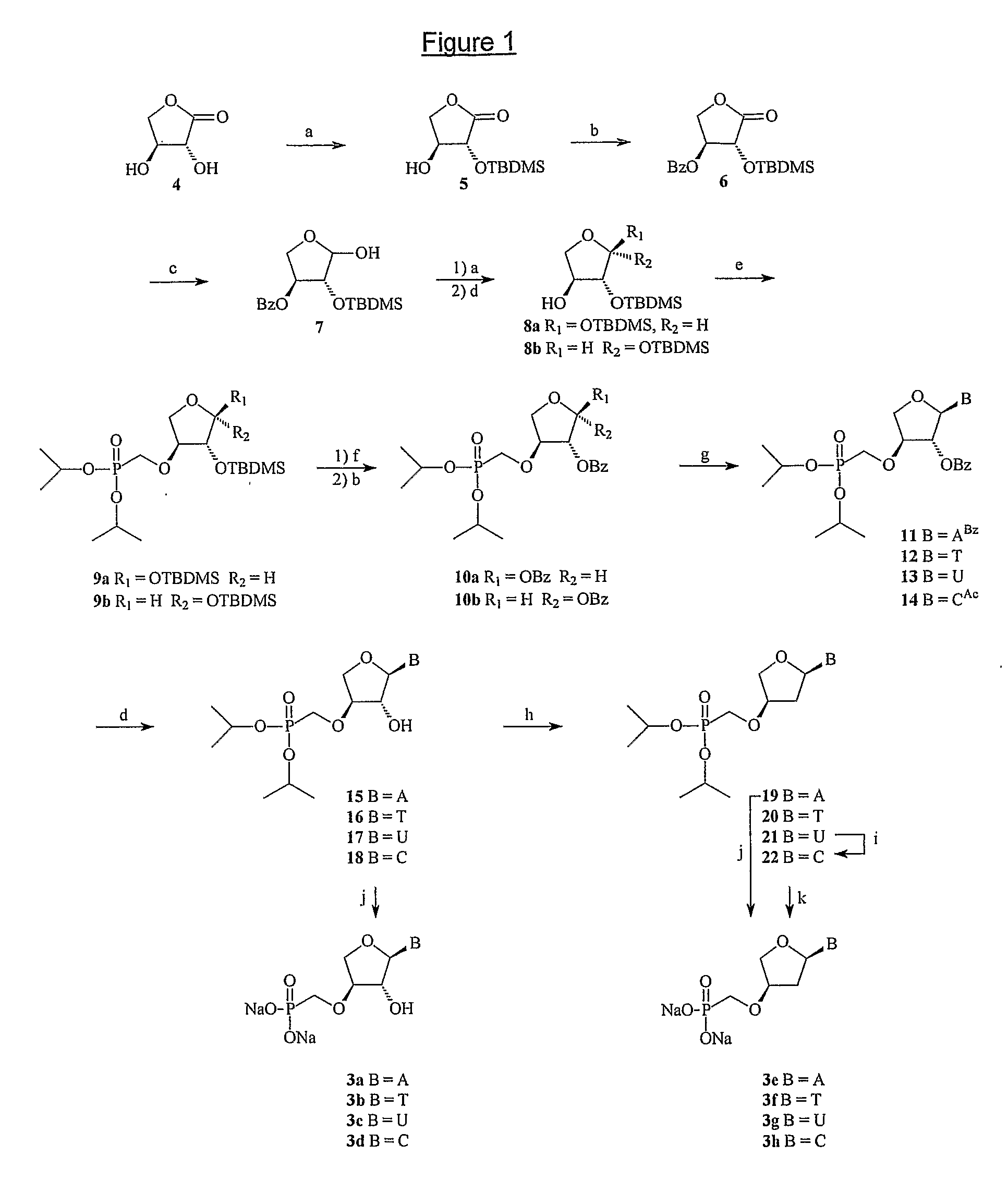Phosponate nucleosides useful as active ingredients in pharmaceutical compositions for the treatment of viral infections, and intermediates for their production
a technology of phosphonate nucleosides and active ingredients, applied in the field of novel, can solve the problems of significant economic losses, low selectivity of many antiviral agents, side effects and toxicities, etc., and achieve the effect of fine tuning the antiviral activity of the novel, poor substrate properties, and poor antiviral activity
- Summary
- Abstract
- Description
- Claims
- Application Information
AI Technical Summary
Benefits of technology
Problems solved by technology
Method used
Image
Examples
example 2
Materials and General Preparation Methods
[0291] For all reactions, analytical grade solvents are used. All moisture sensitive reactions were carried out in oven-dried glassware (135° C.) under a nitrogen atmosphere. Anhydrous THF was refluxed over sodium / benzophenone and distilled. A Varian Unity 500 MHz spectrometer and a 200 MHz Varian Gemini apparatus were used for 1H NMR and 13C NMR. Exact mass measurements were performed on a quadrupole time-of-flight mass spectrometer (Q-Tof-2, Micromass, Manchester, UK) equipped with a standard electrospray-ionization (ESI) interface; samples were infused in i-PrOH / H2O 1:1 at 3 μL / min. Precoated aluminum sheets (Fluka Silica gel / TLC-cards, 254 nm) were used for TLC; The spots were examined with UV light. Column chromatography was performed on ICN silica gel 63-200 60 Å.
[0292] The nucleosides (3a-h) were synthesized starting from (R,R)-2,3-dihydroxy-dihydro-furan-1-one (4) according to FIG. 1. The hydroxyl group in position 2 can be selectiv...
example 3
Preparation of Intermediate Compounds
2-O-tributyldimethylsilyl-L-threonolactone (5)
[0294] To the solution of (3R,4S)-dihydro-3,4-dihydroxyfuran-2(3H)-one 4 (10.8 g, 92 mmol) and imidazole (12.5 g, 184 mmol) in 250 mL MeCN was added TBDMSCl (31.2 g, 3.17 mmol) at 0° C. in one portion. The reaction mixture was slowly warmed to room temperature and stirred overnight. The reaction mixture was concentrated. The residue was partitioned between H2O and EtOAc. The organic layer was washed with water and brine, and concentrated in vacuo. The residue was purified by chromatography on a silica gel column (n-hexane / EtOAC=6:1) to afford 5 (15.2 g, 65.4 mmol, yield 71%) as a colorless solid which was characterized as follows:
[0295]1H NMR (200 MHz, DMSO-d6) δH 0.12 (s, 6H, SiCH3), 0.90 (s, 9H, CH3), 3.86 (dd, J1=6.96 Hz, J2=7.70 Hz, 1H, C(4′)Ha), 4.11-4.36 (m, 3H, OH, C(3′)H, C(4′)Hb), 5.82 (d, J=5.13 Hz, 1H, C(2′)H); 13C NMR (200 MHz, DMSO-d6) δC −4.93(SiCH3), 17.99 (C(CH3)3), 25.61 (C(CH3)3),...
example 4
Preparation of Final Compounds
1-(N6-benzoyladenin-9-yl)-2-O-benzoyl-3-O-(diisopropylphosphonomethyl)-L-threose (11)
[0310] To a mixture of 10a (425 mg, 0.83 mmol) and silylated N6-benzoyladenine (401 mg, 1.6 mmol) in dry MeCN (30 mL) was dropwise added SnCl4 (0.3 mL, 2.5 mmol) under N2 at room temperature The reaction mixture was stirred at room temperature for 4 to 5 hours. Then the reaction was quenched with saturated NaHCO3. and concentrated. The residue was partitioned between H2O (20 mL) and EtOAc (100 mL). The organic layer was washed with water and brine, and concentrated in vacuo. The residue was purified by chromatography on a silica gel column (DCM / MeOH=40:1) to afford 11 (431 mg, 0.69 mmol) as a colorless amorphous solid in 83% yield which was characterized as follows:
[0311]1H NMR (500 MHz, CDCL3) δH 1.31-1.36 (m, 12H, CH3), 3.94 (dd, J1=14.0 Hz, J2=8.6 Hz, 1H, PC Ha), 4.01 (dd, J1=14.0 Hz, J2=8.6 Hz, 1H, PC Hb), 4.38 (dd, J1=11.0 Hz, J2=4.6 Hz, 1H, C(4′)Ha), 4.50-4.52 ...
PUM
| Property | Measurement | Unit |
|---|---|---|
| Antimicrobial properties | aaaaa | aaaaa |
Abstract
Description
Claims
Application Information
 Login to View More
Login to View More - R&D
- Intellectual Property
- Life Sciences
- Materials
- Tech Scout
- Unparalleled Data Quality
- Higher Quality Content
- 60% Fewer Hallucinations
Browse by: Latest US Patents, China's latest patents, Technical Efficacy Thesaurus, Application Domain, Technology Topic, Popular Technical Reports.
© 2025 PatSnap. All rights reserved.Legal|Privacy policy|Modern Slavery Act Transparency Statement|Sitemap|About US| Contact US: help@patsnap.com



